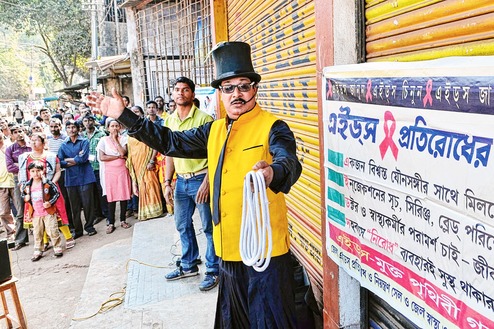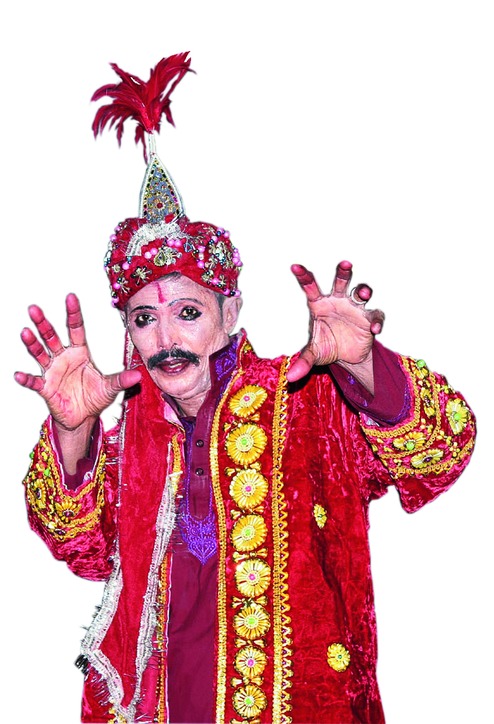Magicians tell Uddalak Mukherjee why the fun has gone out of their craft

Dipak Roychowdhury’s life had changed one evening in 1983. Roychowdhury, a magician – he had learnt the ropes from the legendary Gautam Guha, who had taught the tricks of the trade to even Satyajit Ray – was scheduled to perform at an event organised by the Communist Party of India (Marxist). The problem was that P. Ramamurthi, the veteran Marxist, was expected to speak before Roychowdhury’s performance. The magician, he was a young man then, feared that the crowd would leave with the politburo member. But the crowd, a packed house at Rabindra Sadan, chose to stay. Since that day, Roychowdhury – he now teaches magic to children in a school in Brahmapur – spent 12 years travelling all over Bengal with his bag of tricks. He still loves talking about that evening in 1983.
Sanjoy Chatterjee’s life, on the other hand, had been changed by a book. Chatterjee had bought Ganapati Chakraborty’s Jadu Bidya for four-and-a-half rupees almost three decades ago. The book, a sort of a Bible for amateur magicians, was Chatterjee’s key to a magical kingdom that he has called home since.
The Magic Mela organised by the Federation of Indian Magic Associates (Fima), now in its fourth edition, had brought together young and old performers like Chatterjee and Roychowdhury at Calcutta’s Mohorkunja ground recently. A motley crowd hung around savouring not just the acts performed by magicians – they had gathered for the occasion from near and far – but also the merchandise that was on show.
Chatterjee and Roychowdhury shared their stories and their views on the art of magic at Fima’s tiny office at the venue. The Magic Mela, held between March 28 and 30 this year, is an initiative that seeks to provide a durable platform for magicians all over the country to reach out to a wider audience and a market. According to Chatterjee, Fima has enlisted almost 950 performers in its ranks. Hearteningly, it also accommodates affiliates that are integral to magic’s ecosystem. For instance, at the Magic Mela, one also came across Samdari Lashkar, whose family firm has been supplying magic equipment for over three generations to almost 48 countries.
The conversation with the artists mostly centred on the changes that magic has had to endure as a profession. Some of these transformations are encouraging. Chatterjee talked about the support from the government. The venue for the Magic Mela had been provided free of cost. He added that there has been some progress in talks with a telecommunications giant to build a magic academy in New Town, Rajarhat. There has also been noticeable improvement in the quality of props – without these a magician would be crippled on stage.
But some of the other challenges, Chatterjee said, merit concern. Even though magic as a profession has become far more accessible, there has been a precipitous decline in the spirit of individual innovation. Most magicians seem to be content with replicating popular tricks without adding new dimensions to them. Funds remain short, perennially. Magicians, especially underprivileged performers who ply their trade in, say, local trains, lack medical insurance. There is also an acute need for pension for aged artistes. But the biggest threat – Chatterjee mentioned this more than once during the interview – comes from new-age technology. The digital media, no less mighty a sorcerer, is weaning children, magic’s most trusted patrons, away.
Roychowdhury, however, confided that he has a trick up his sleeve to bring children back to magic – education. As a teacher, he insists that budding magicians would first have to learn the trick of striking a chord with spectators. Magic, in his opinion, should transcend the trappings of illusion. It should, instead, function as a tool that helps the audience relate to their own lives.
Evidently, Roychowdhury views magic not merely as a livelihood. Magic’s philosophical dimensions consume him. For instance, he talked animatedly about the decline in the purity of form in magic. This he attributed to the increasing commercialisation of the craft. Incidentally, Roychowdhury’s reservations had been echoed by Ray in his short story, Dui Magician, where Tripuracharan Mallick, an advocate of magic as an aesthetic sensibility, accuses his ward, Surapati Mondal, of falling prey to the lure of razzle-dazzle.
Roychowdhury also described the relationship between the performer and his audience as one of power and asymmetry. Perhaps he was referring to the magicians’ temporary hold over the patrons.
So does he miss it now? The thrill of putting a spell on an audience?
The crowd outside the Fima office was leaving as the first day of the Mela was coming to a close. Roychowdhury heard the question, took sometime to reflect, and then answered in a rather quiet tone: “I miss the sight of a packed hall the most.”
source: http://www.telegraphindia.com / The Telegraph,Calcutta,India / Home> Calcutta / by Uddalak Mukherjee / April 21st, 2018
